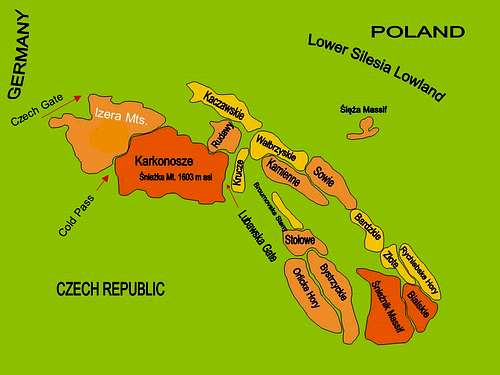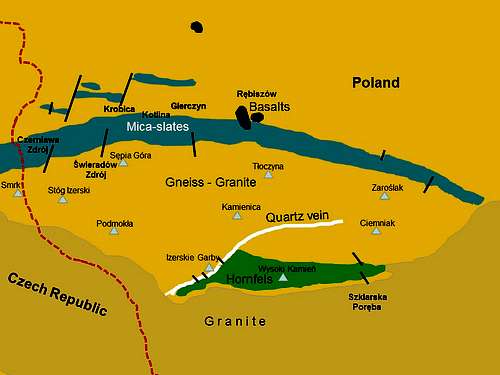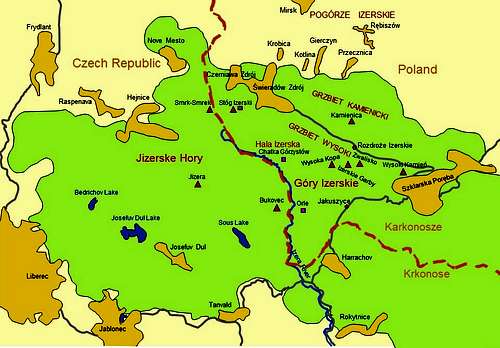-
 620 Hits
620 Hits
-
 75.81% Score
75.81% Score
-
 6 Votes
6 Votes
|
|
Album |
|---|---|
|
|
Informational |
SHORT GEOLOGICAL OVERVIEW
“See more, know more, give more…..”
The mountains of the Earth have been used by humans for thousands of years. The cultures of ancient Babylonia, Egypt, and the younger cultures of South America existed thanks to the use of rocks and minerals. To this day, we can find traces of ancient rock excavations. The history of human existence in the Izera Mountains dates back to the Middle Ages. Sometimes you can come across traces of the former presence and work of the Walloons. While searching for treasures, they discovered the geology of the area. When we live or visit the mountains, we also get to know them. Not only their beauty, but also the knowledge of their geology, climate, flora and fauna enrich us. If we already know something, we can share this knowledge with other people. My mountain motto is: "Mountains? See more, know more, give more. ”. This information album, which is a part of this "giving", presents specimens of minerals and rocks obtained from places of their former exploitation, inactive quarries and mines, mine output accumulated in heaps or scattered on mountain trails. In addition, the natural erosion of the mountains makes it possible to find interesting specimens of rocks and minerals in alluvia of rivers and streams. In the Izera Mts., such places are the old quartz quarries on the Izerskie Garby and at Rozdroże Izerskie, in the northern slate range with a rich mineralization of tin and cobalt compounds, as well of accompanying minerals, where in the nineteenth century there were many mines extracting them, and in alluvia of many watercourses such as : Kwisa, Kamienica, Kamienna, Izera, Jagnięcy Potok, Mokrzyca, Kobyłka and others.
The Izera Mts. are built by variscan granite and by surrounding metamorphic rocks like gneisses, granitoids and mica schists. History of these rocks starts with the Caledonian orogenesis in the Paleozoic Era. Here one can find ring-eyed, fine-grained or fine-eyed gneisses. Granitoids of a special type with blue sapphire quartz are called the Rumburk granite, another one is a light leucogranite. In the Rumburk granite on the Kamienicki Range and on slopes of the Mount Smrek, as well as in the alluvia of the Kwisa River, nice pieces of smoky quartz could be found. Slates composed of muscovite-sericite-chlorite are grey, silvery-grey or green-grey and constitute the northern part of the mountains called Grzbiet Kamienicki (Kamienica Range). Very hard, dark and fine-grained hornfelses created by the metamorphosed slates are the main component of Wysoki Grzbiet (High Range), from Wysoki Kamień Mt. to Izerskie Garby Mt. They were formed as a result of the metamorphosis of older slates under the influence of younger, high-temperature granite magma of Karkonosze Mts. They are especially common within a contact zone between geologic massifs of the Izera Mts. and Karkonosze Mts. In metamorphic rocks, there was a crystallization of a huge vein of pure quartz in the Izerskie Garby (1084 m a.s.l) as well as appearance of basalts along a line of a tectonic fault between Stara Kamienica and Rębiszów, on the northern edge of the Izera Mts. On Izerskie Garby, a large mine excavating quartz was active through a long time and as a consequence of this, almost a half of the mountain has been devoured. Fortunately for the nature, this mine is closed for many years. Today this image of Izerskie Garby creates new offers for people learning the geology and mineralogy of these mountains besides being suitable for new pioneer plants and animals. In the eastern wall of the mine, a vein of skarn, some kind of metamorphic calc-silicate rock, contains many minerals: wollastonite, stilbite, apophyllite, diopside, vesuvianite, garnets (grossular, hessonite), fluorite, calcite, tremolite and actinolite. Another part rich in minerals there are northern slopes of Grzbiet Kamienicki where many ores like cassiterite, safflorite and smaltine were mined from slate layers. It is also possible to find beautiful almandine garnets and crystals of chalcopyrite, arsenopyrite and galena in these slates. In the Izera Mts., especially in their central part in Hala Izerska since the XVIth century, precious and semi-precious stones were gathered in the Jagnięcy Potok. This stream starts from springs on slopes of Wysoka Kopa Mt. and eroding the bottom it accumulates many heavy minerals in alluvia. Nice specimens of ilmenite, gold, sapphires, zircon, corundum, beryl, topaz, garnets and tourmaline were found here.




